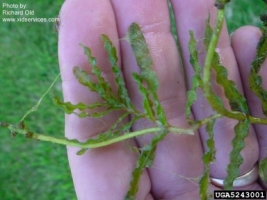Food for Thought (Nutrition)
Curly leaf pondweed is classified an autotroph; that means
that it uses carbon dioxide and water in the process of
photosynthesis to create sugars for energy. This submerged
macrophyte is an important primary producer within the habitats
that it lives!
Because this organism lives underwater, obtaining carbon is much more difficult than
if it lived on land. To combat the high density and viscocity of water, 30%
of its carbon-dioxide fixation (or, the breaking down of this
molecule to carbon) is done through a form of
 photosynthesis
known as CAM (or Crassulasean acid metabolism).
photosynthesis
known as CAM (or Crassulasean acid metabolism).
Here's a quick run-down of photosynthesis:
In curly leaf pondweed, 70% of photosynthesis is done just how most plants utilize light energy to produce sugars.. During the light reactions, energy from waves of light is absorbed by chlorophyll and used to create ATP and NADPH; two essentials for the dark reactions. The dark reactions (otherwise known as the Calvin cycle) turn carbon-dioxide, through a series of reactions, into sugars that can be used by the plant for a variety of fuctions!

C4 plants transform carbon-dioxide in a slightly different manner; before carbon enters the dark reactions, carbon dioxide is first incorporated into several organic intermediates. These organic compounds are then worked into the Calvin cycle to make sugars. Unlike other C4 plants, however, curly leaf pondweed does not store carbon overnight to prevent water loss. Instead, curly leaf pondweed undergoes this type of photosynthesis to complement the carbon it gains during regular photosynthesis. This nifty adaptation allows Potamogeton crispus to maximize carbon gain!
 Just like a
silver carp (pictured left) or human, curly leaf
pondweed requires a variety of other macro and
micronutrients to help it grow big and strong. Most of these
nutrients are absorbed through the roots from the soil.
While carbon, hydrogen, and oxygen are necessary ingredients
for photosynthesis, other macronutrients are just as
important in the proper functioning of this plant! Curly
leaf pond weed requires specific levels of nitrogen to make
nucleic acids, chlorophyll, proteins, and certain plant hormones. while phosphorus is
Just like a
silver carp (pictured left) or human, curly leaf
pondweed requires a variety of other macro and
micronutrients to help it grow big and strong. Most of these
nutrients are absorbed through the roots from the soil.
While carbon, hydrogen, and oxygen are necessary ingredients
for photosynthesis, other macronutrients are just as
important in the proper functioning of this plant! Curly
leaf pond weed requires specific levels of nitrogen to make
nucleic acids, chlorophyll, proteins, and certain plant hormones. while phosphorus is
 used in the production of ATP
and phospholipids. Curly leaf pondweed also requires a certain amount of calcium just like
humans; this
macronutrient helps in the stability and function of cell
walls, as well as maintenance of cell membrane structure and
permeability.
used in the production of ATP
and phospholipids. Curly leaf pondweed also requires a certain amount of calcium just like
humans; this
macronutrient helps in the stability and function of cell
walls, as well as maintenance of cell membrane structure and
permeability.
Important micronutrients include iron, chlorine, zinc, copper, boron, and magnesium.
Now THAT is some food for thought! Continue to REPRODUCTION to continue learning about curly leaf pondweed!